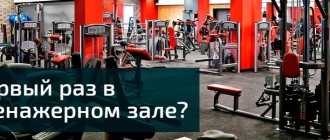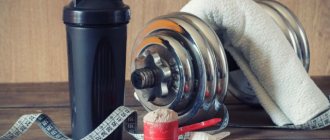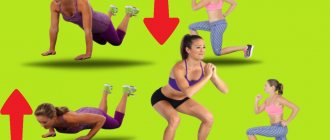Can't find a muscle-building workout program that best suits your goals? Read this guide! The 3, 4, and 5 day splits outlined here may be the best to help you build muscle.
- Training programs for gaining muscle mass
- Mass training program 3 times a week for all muscle groups Example of a 3-day split
- Sample 4-day split
- Sample 5-day split
Training programs for gaining muscle mass
There is often a lot of confusion about what splits to follow when building muscle. There are several options, and each of them is effective.
The main question is which training regimen is best for you. Let's look at the most common splits today so that you can make an informed decision when choosing a suitable complex.
Intense workout
The purpose of this stage is to activate slow muscle fibers and stimulate them to grow. Despite the fact that the number of repetitions is 8 and this means that the working weight can be reduced, the rest between sets is no more than 2 minutes.
To make the workout truly intense, supersets are introduced into the training regimen.
Please note: the relaxation phase (negative) should be 2 times longer than the effort phase (lifting or pushing the weight).
Mass training program 3 times a week for all muscle groups
This training program for gaining muscle mass is 3 times a week, every other day, followed by 2 days of rest.
It is usually used by beginners and involves training all parts of the body three times.
This three-day mass split is suitable for beginners for many reasons:
- It allows you to master each exercise by performing them repeatedly several times a week.
- Since most beginners do not have the same strength as advanced lifters, they benefit from training their muscles more often with light weights to avoid the need for a long recovery time.
- A beginner's body will be better able to build muscle mass even if you don't train too often. Take advantage of this privilege because you may never have it again. Each muscle gains strength only in the first year of training. In order for muscles to grow, you must allow the body to properly recover and adapt to the stress. A three-day split is a good start for beginners and will eventually allow you to progress to higher training volumes with higher frequency.
Example of a 3-day split
Day 1
- Barbell Squats - 4 sets, 8 reps
- Medium grip bench press - 4 sets, 8 reps
- Pull-ups - 4 sets, 8 reps
- Military Press - 4 sets, 8 reps
- Barbell Curls - 4 sets, 8 reps
- Rollouts with a gymnastic roller (abs) - 4 sets, 8 reps
Day 2
Rest
Day 3
- Barbell deadlift - 5 sets, 5 reps
- Bent-over barbell rows - 5 sets, 5 reps
- Incline Dumbbell Press - 5 sets, 5 reps
- Dumbbell lateral raises - 5 sets, 5 reps
- Dumbbell Overhead Extension – 5 sets, 5 reps
- Hammer Grip Dumbbell Raises - 5 sets, 5 reps
Day 4
Rest
Day 5
- Lunges with dumbbells - 3 sets, 12 reps
- Dips (with emphasis on triceps) - 3 sets, 12 reps
- Pull-ups to the chest - 3 sets, 12 reps
- Standing Kettlebell Press with Push - 3 sets, 12 reps
- Seated calf raises - 3 sets, 12 reps
- Body twists with weight plate - 1 set, 12 reps
Day 6
Rest
Day 7
Rest
When to practice?
Training 4 times a week is a serious challenge for a beginning athlete. It is important to structure the week in such a way as to fully work out all muscle groups, but at the same time leave time for normal rest of the body and nervous system.
The main principle from which to build is that large muscle groups need 60 to 72 hours to recover. The large groups are the lats and upper back, pecs, buttocks and thighs. Thus, at least 2.5 days must pass between the load of these zones. But small groups recover much faster - from 24 to 48 hours, so biceps, triceps, deltoids and abs can be worked out much more actively, even every other day.
There are three schemes for such classes:
- 4 workouts in a row, 3 days rest;
- 2 days – work, 1 day rest, 2 days work and another 2 days rest;
- 3 workouts in a row, 2 days of rest, 1 lesson, 2 days of fasting.
The most convenient and correct way is training 2 through 1. This scheme is suitable for a full four-day split, since different muscle groups are loaded on training days 1 and 2.
4 or 3 classes in a row also have a right to exist, but only with a competent approach. Here it is important to accurately calculate the speed of recovery of muscle groups in order to be able to work out the body well and not burn out due to constant stress.
A four-day split without rest days is not recommended for beginners. A person who has not played sports before may encounter a number of difficulties when choosing such a program:
- constant fatigue;
- heavy load on the nervous system;
- injuries;
- burnout;
- slow progress.
In the first two months of training in the gym, it is recommended to choose a three-day basic program to prepare the body for further muscle hypertrophy. If you already have some experience, you can try a four-day program, but you should be prepared for the fact that after 3-4 weeks you will experience a loss of strength.
Mass training program 4 times a week
This split is typically used by intermediate athletes.
There are many variations, but the most common pattern is: upper body, lower body (the next day), rest day, upper body, lower body.
Plan your workouts and rest days according to your daily schedule.
The reason splits are considered intermediate is because as you train longer and increase weights, you need to rest more to allow your body parts to recover properly between workouts. Here you reduce the frequency of training each muscle, but increase their number to 5 per week.
You should switch to this split after 3-6 months of training on a 3-day split. This approach will allow you to build more muscle mass.
Sample 4-day split
Day 1: Upper Body
- Bench press with medium grip - 4 sets, 6-8 reps
- Bent-over barbell row - 4 sets, 6-8 reps
- Seated dumbbell press - 3 sets, 10-12 reps
- Dumbbell Curls - 3 sets, 10-12 reps
- Crossover arm extension (with rope) - 3 sets, 10-12 reps
Day 2: Lower Body
- Front squats with barbell - 4 sets, 6-8 reps
- Barbell deadlift - 3 sets, 6-8 reps
- Lunges with dumbbells - 3 sets, 6-8 reps
- Seated leg extension - 3 sets, 10-12 reps
- Standing calf raises - 3 sets, 10-12 reps
Day 3
Cardio/Rest
Day 4: Upper Body
- Close-grip incline bench press - 4 sets, 6-8 reps
- Wide grip chin pull-down - 4 sets, 6-8 reps
- Military standing press - 3 sets, 10-12 reps
- Raising dumbbells in front of you - 3 sets, 10-12 reps
- Reverse push-ups - 3 sets, 10-12 reps
Day 5: Lower Body
- Barbell Squats - 4 sets, 6-8 reps
- Deadlift with a barbell on straight legs - 4 sets, 6-8 reps
- Single leg press - 3 sets, 10-12 reps
- Double leg press - 3 sets, 10-12 reps
- Seated calf raises - 3 sets, 10-12 reps
Day 6
Cardio/Rest
Day 7
Cardio/Rest
Program description
The weight gain training program is designed for athletes of average training level who:
- We have achieved our first successes and are confident that we know how to build muscle.
- Mastered the correct technique for performing basic compound movements.
- They know how to create an effective diet for gaining muscle mass.
Overload.
For muscle building, the overload factor is of enormous importance. Bring each set to the maximum number of repetitions and end it at the moment when the technique begins to limp, or when you realize that muscle failure awaits you on the very next repetition. Don't train to failure. The goal is to speed up mass gain, and not deplete the body and central nervous system.
Increase the weight on each exercise as often as possible, but only when it makes sense. I recommend using the same weight for each set of an individual exercise, and when you can confidently complete the planned number of repetitions in all sets, increase the load.
Rep range.
The rep range is just a guideline. It's okay if you go overboard or stop at the lower end of your range from time to time. Again, the deciding factor is overload. Rep ranges are just a tool.
5 minute burns.
There are 5-minute burning sessions for each part of the body. These approaches are particularly cruel. Use a weight that allows you to do about 12-15 reps. In 5 minutes, do as many reps as you can with this weight, resting as needed. The pauses should be short - catch your breath, regain some strength, and continue to increase the rep count.
5-minute burnout sets are not performed to the intended number of sets and repetitions. The task is to completely exhaust the already tired muscles. Don't worry (you don't even have to count) about the number of sets and repetitions. Instead, try to do as many reps as possible, resting just long enough to avoid collapsing from fatigue.
Training program for gaining muscle mass for 5 days
The 5 day mass split is the most advanced.
Of course, there are splits that involve 7 workouts per week or even 2 workouts per day. However, for 99% of natural athletes, I recommend a 5-day split.
When you train for 2 years or more, it becomes more difficult to progress in building strength (due to adaptations of the central nervous system). You may even find it difficult to build muscle mass.
This does not mean that the body completely loses the ability to perform these processes. It will simply become more difficult for you to activate them.
In this situation, it is best to increase the volume of muscle loads per day and provide a longer period for recovery and growth.
Sample 5-day split
Day 1: Chest
- Bench press with medium grip - 3 sets, 12 reps
- Incline Dumbbell Press - 3 sets, 12 reps
- Incline dumbbell press with head down - 3 sets, 12 reps
- Lying lateral raises - 3 sets, 12 reps
- Crossover raises - 3 sets, 12 reps
- Barbell Pullover - 3 sets, 12 reps
- Weighted crunches - 3 sets, 12 reps
- Bench leg raises - 3 sets, 12 reps
- “Russian twist” - 3 sets, 12 reps
Day 2: Back
- Deadlift - 3 sets, 12 reps
- Weighted pull-ups - 3 sets, 12 reps
- Bent-over grip dumbbell row - 3 sets, 12 reps
- Bent-over dumbbell rows - 3 sets, 12 reps
- Wide grip chin pull-down - 3 sets, 12 reps
- Dumbbell Shoulder Raise - 3 sets, 12 reps
Day 3
Rest
Day 4: Shoulders
- Seated dumbbell press - 3 sets, 12 reps
- Arnold Press - 3 sets, 12 reps
- Dumbbell lateral raises - 3 sets, 12 reps
- Front dumbbell raises - 3 sets, 12 reps
- Barbell Chin Row - 3 sets, 12 reps
- Weighted crunches - 3 sets, 12 reps
- Bench leg raises - 3 sets, 12 reps
- “Russian twist” - 3 sets, 12 reps
Day 5: Legs
- Barbell Squats - 3 sets, 12 reps
- Double leg press - 3 sets, 12 reps
- Barbell lunges - 3 sets, 12 reps
- Leg extension - 3 sets, 12 reps
- Seated Leg Curls - 3 sets, 12 reps
- Bent-over calf raises with weights on the back - 3 sets, 12 reps
Day 6: Hands
- Close grip bench press - 3 sets, 12 reps
- Crossover V-Bar Extension - 3 sets, 12 reps
- V-bar rows - 3 sets, 12 reps
- Barbell Curls - 3 sets, 12 reps
- Alternating Dumbbell Curls - 3 sets, 12 reps
- Smith machine barbell curl - 3 sets, 12 reps
- Reverse grip barbell curl - 3 sets, 12 reps
- Weighted crunches - 3 sets, 12 reps
- Bench leg raises - 3 sets, 12 reps
- “Russian twist” - 3 sets, 12 reps
Day 7
Rest
Hard workout
Despite the fact that it is complex, it is distinguished by its simplicity. The list of exercises is basic, there are no simulators. Pause between approaches 3-5 minutes. The goal of the training is large muscles, small ones are minimally involved.
A hard workout is a test for your ligaments and tendons, so give your knees, shoulders and elbows a good stretch before training.
Recommendations for determining the level of training
If you do not know which category to classify your level of training in, then use the following recommendations:
- Beginner level: 6 months or less of strength training.
- Average: 6-18 months of strength training.
- Advanced: 24 months or more of regular strength training.
If you haven't been exercising regularly for several years, you might consider yourself average. However, you can also start with a beginner program to prepare your body for more advanced splits. This is left to your choice.
Once you determine your fitness level, choose the program that best suits your individual goals. Be patient and consistent. This is the only way you can progress and see impressive results.
Power training
The training style is similar to the heavy one, which was the first in the article, with the difference that the number of repetitions is increased to 10 and the arsenal of exercises is modified. All exercises are also basic, heavy, the duration of rest between approaches is reduced to 2-3 minutes.
Afterword
What's next? Then everything repeats again: a hard week, then an easy one, then again a hard one and again an easy one, a hard week, an easy one, and so on. The only and basic rule is that every hard week you should increase (or try to increase) the working weights. We adhere to this two-point rule. Point one. If you can perform a given number of repetitions technically correctly and without the help of a partner, increase the weight. Point two. If you can’t, work with weights until you can do step one.
How long to stick to this mass-gaining periodization scheme? As much as you want. It can be used endlessly. I leave this task for your independent work. For everyone determines for himself what he needs, what he wants to achieve, and what result he sets himself the goal of achieving. Our task is only to show how to do this.
How to do the first and second week
To start, choose one of the circuit training sessions and do one circuit for five days - it will take 10 minutes. You can do the same complex or alternate them - as desired. On one of your rest days, go for a walk. Perform the movements below in order for the indicated number of times.
In the second week, do the same, but now do two circuits of the workout for two days. For example, your graph might look like this:
- Monday: two rounds of workout #1.
- Tuesday: one lap of workout #2.
- Wednesday: One lap of workout #1.
- Thursday: two laps of workout #2.
- Friday: walking.
- Saturday: one circuit of each workout.
- Sunday: rest.
Workout #1
Head tilts
Do five neck flexions and extensions. Move smoothly, without jerking.
Circular movements of the head
Perform three circles in each direction. Try to move through your full range.
Circles with hands
Perform five rotations forward and backward.
Walking in place with a high hip lift
Do 20 times in total. Try to raise your knees higher, keep your body rigid and your back straight. Do not bend the knee of your supporting leg.
Standing leg raise
Try to raise your limbs higher, but make sure that the knee of the supporting leg does not bend and the pelvis does not move forward. Tighten your abs and keep your back straight. Perform 10 lifts on each leg.
Lying Y fly
Perform 10 lifts. If you want to increase the load, pick up light dumbbells or 0.5 liter plastic bottles filled with water.
Lying T fly
Place your arms clearly at your sides, raise and lower. Do it 10 times.
Lying W fly
Bend your elbows so that they resemble the letter W, raise and lower in this position. Do it 10 times.
Plank
Stand in a plank position on your forearms, stretch your body in one straight line, tighten your abs and buttocks. Hold the position for 5 to 30 seconds. When you feel that the muscles cannot cope and the pelvis begins to sink, get out of the pose.
Bird - dog
Get on all fours and simultaneously straighten your opposite arm and leg. Make sure that your lower back does not collapse, tense your abs. Do five reps on each side.
Lowering and rising from the floor without hands
Sit on the floor, cross your legs cross-legged, and then try to get up without using your hands. How exactly does not matter. If you can't do this, use one hand, but try to lean on it as little as possible. Complete 10 reps.
Glute Bridge Hold
Photo: Yulia Obolenskaya
Lie on your back, bend your knees and place your feet on the floor. Lift your pelvis off the floor and extend your body in one line from your knees to your shoulder blades. Maintain tension without letting your butt sink to the floor. Hold in position for 5 to 30 seconds.
Workout #2
Head tilt on all fours
Get on all fours, bending and extending your neck, trying to move through the full range. Do five lifts and lowerings of your head.
Rocking on all fours
Without lifting your arms and legs from the floor, move your body back and forth, stretching your shoulders and stretching the muscles on the back of your thighs. Perform five back-and-forth movements.
Leg extension on all fours
Remaining on all fours, raise your bent leg until your thigh is parallel to the floor or slightly higher. Feel the tension in the gluteal muscle; you can additionally tense it at the top of the movement.
Watch your lower back - it should not bend when you lift your leg. Return the knee back to the floor and repeat on the other side. Do five reps on each leg.
Plank
Make sure your body is level. If there are no problems with your wrists, you can try resting on your palms.
Swing your arms
Raise your arms above your head to the sides and lower them back down. Move with energy. Do it 10 times.
Bent-over Y-raises
Bend until your body is parallel to the floor or close to it. Raise and lower your arms, feeling the tension in your back muscles. Do 15 times.
Body rotations
Place your feet wide, raise your arms to the sides to shoulder level, straighten your back. Turn your body to the left, look behind your back, repeat the same in the other direction. Perform five turns.
Static wall squat
Squat down next to the wall, leaning your back against it. Ideally, you need to achieve parallelism between your thighs and the floor so that your legs are bent at the knees at a right angle. But if this is too difficult, you can reduce the depth of the squat. Hold the position for 5 to 30 seconds.
Wall push-ups
Stand a step away from the wall, place your palms on it at shoulder level, fingers facing forward. Bend your elbows, lowering yourself closer to the wall, then rise back up. Make sure your body remains rigid and your back straight. Do not place your elbows to the sides - they should look back.
If you feel discomfort in your wrists, try placing your fists on the wall, but in this case, be sure to point them with your thumbs up so that your elbows go back during the push-up.
Leg raises while lying on your side
Raise and lower your leg while maintaining a straight body position. Perform 10 times on each side.
Superman
Lie on your stomach and lift your chest and shoulders, straight arms and legs at the same time. Lower back down and repeat four more times.
Exercises
You can find a complete illustrated description of the exercises given in this program, the technique for performing them and tips by following the links to articles with the appropriate title: Exercises for the chest muscles Exercises for the back muscles Exercises for the leg muscles Exercises for the shoulder muscles Exercises for the biceps Exercises for triceps exercises for abdominal muscles











